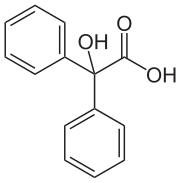 | |
 | |
| Names | |
|---|---|
| Preferred IUPAC name Hydroxydi(phenyl)acetic acid [1] | |
| Other names α,α-Diphenyl-α-hydroxyacetic acid, α,α-Diphenylglycolic acid, α-Hydroxydiphenyl acetic acid, 2,2-Diphenyl-2-hydroxyacetic acid, 2-Hydroxy-2,2-diphenylacetic acid, Diphenyl glycolic acid, Hydroxydiphenyl acetic acid | |
| Identifiers | |
3D model (JSmol) | |
| 521402 | |
| ChEBI | |
| ChEMBL | |
| ChemSpider | |
| ECHA InfoCard | 100.000.904 |
| EC Number |
|
| 281752 | |
PubChem CID | |
| UNII | |
CompTox Dashboard (EPA) | |
| |
| |
| Properties | |
| C14H12O3 | |
| Molar mass | 228.247 g·mol−1 |
| Appearance | white solid |
| Density | 1.08 g/cm3 |
| Melting point | 150 to 152 °C (302 to 306 °F; 423 to 425 K) |
| Boiling point | 180 °C (356 °F; 453 K) (17.3 hPa) |
| 2 g/L (20 °C) | |
| Hazards | |
| GHS labelling: | |
 | |
| Warning | |
| H302 | |
| P264, P270, P301+P312, P330, P501 | |
| NFPA 704 (fire diamond) | |
Except where otherwise noted, data are given for materials in their standard state (at 25 °C [77 °F], 100 kPa). | |
Benzilic acid is an organic compound with formula C
14H
12O
3 or (C
6H
5)2(HO)C(COOH). It is a white crystalline aromatic acid, soluble in many primary alcohols.
